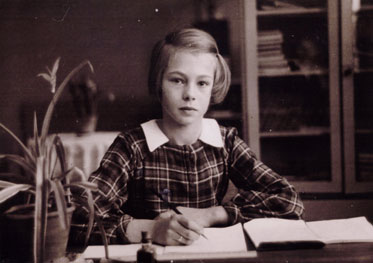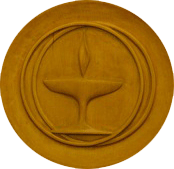
PROFILE: ADA NANNING
-
Born 1929, Amsterdam; died 2012, Edmonton
-
In Her Words...
-
"People who come through our door know there is no discrimination for any reason."
HOME / OUR HISTORY / TIMELINE / MINISTERS / PROFILES / PHOTO ALBUMS / CONTACT US
Ruth Patrick / Dorothy Keeler / Jack Ratcliff / Ada Nanning / Clarence Collins / Mary Nimmons / Phyllis Ferguson
Marion De Shield / Annabelle & Maurice Bourgoin / Frances Blythe / Bernie Keeler / Morris Simons
Helen Ready / Mary Ayres / Bill Brown
Ada Nanning: A child of war |
||
BY AUDREY BROOKS |
||
|
Ada was born on July 16, 1929 in Amsterdam, the Netherlands. Her parents were Max (Meyer) Witmondt, and Nell (Neeltje) Visser. Her father was Jewish, married to a Dutch wife. Ada had an older brother, also called Max, but his father loved to call him ‘boy’ in English. Max enjoyed nature and studied land management with a focus on how to develop ideal crops for specific locations. He married, had two children and loved to travel and hike in the mountains. Unfortunately, he died too young, from a fall in the mountains while on vacation. But Holland was not ready for war. A little country, it did the best it could, but was not prepared to fight Germany. The Dutch capitulated after only a few days. Ada was eleven years old in 1940 when the Germans rolled in and took over. Everyone hated them. Then she saw people crying in the street. Adults talking about neighbours who were taken away by train to concentration camps. She was not yet a teenager, but she saw and heard the talking about so-and-so being gone now. She saw her girlfriend taken, along with her parents. “They all carried those little suitcases and tried to say goodbye.” Ada’s grandparents and an uncle were also taken to the trains, and were never found again. The Nazis were in buildings throughout the city of Amsterdam. They would always be on the buses, but did not harm the people out of the clear blue. They would take the food, make themselves comfortable as they used their lists of names to find and arrest Jews. Her father was a Jew, but not a religious Jew (he was a humanist). He was not supposed to work in the job he had because of his race. When someone reported this to the authorities he was taken from the street in 1942 and put into a temporary prison. He sent a postcard: From Cell # B2/10... “ I find myself in the German part of the House of Keeping. #2 Havenstraat 6 at Amsterdam. I ask you to send me always on Friday between 9 and 5 clean clothing, well packed in a pillow case and put my name and cell # on it. We are not allowed to receive food items. On Monday the dirty clothes can be picked up.” Ada and her brother used to walk around that place with their mother at 6 p.m. every evening, and yell out ‘yahoo,’ and ‘oo-hoo-hoo.’ Later they heard that everyone in there waited to hear Max Witmond’s children. From people who were released from the House, they learned an alphabet code that could be put on paper napkins, using dots at different levels to send secret messages. After a few weeks Max was transported by train and while travelling to a concentration camp in south Holland, was physically mistreated. He was not badly hurt, but was able to pretend that he was, so was diverted to Westerborg near the German border, where people were processed before being sent to concentration camps. Because he was useful, he was assigned to a job, and stayed in that camp for many months. Meanwhile, his wife Nell, with the help of friends, was able to initiate paper work to show that Max was married to a non-Jew. Ada has many letters that were written from the family members to Max; the family was allowed to write letters and send little parcels through regular channels. He then went to a final camp from which he was discharged. The letters and connections must have had something to do with this. Ada remembers her dad and mom hugging and her being pulled into the circle. Then Ada became involved in the resistance movement herself. There were people hiding from the Nazis. There were people coming and going; her parents would pull the curtains and there were secret meetings. Ada heard things. Some of the underground had radios. ‘Word gets out!’ The underground was destroying train tracks, so the enemy couldn’t use them. They talked about getting some Jews out to the farms. Ada says: “I felt so hopeless and useless because I could do nothing! Then they were talking and I threw a temper tantrum, which I never did before. I asked: ‘When can I do something?’ The next morning my mother said: ‘We have a job for you.’ I think this kept my sanity. I was given a small modest job that had to be done, which was taking food cards which had been stolen from the enemy to people in hiding. These people could be Jews or workers for the underground who were hiding from Nazi searchers. Later, her dad and other Jewish men married to non-Jewish wives had to go to Zandfort in the west of Holland to put barbed wire on the beach and into the ocean to repel the British, in case they would invade. While there, Mother and children were allowed to visit. Ada remembers one visit where there was entertainment, musicians, comedians and artists. “They were Jews and we had a fantastic evening -- the craziness of war!” When the war ended, Ada took one year of teacher training, and taught for part of a year before deciding it was not for her. She then enjoyed working in a bookshop selling mainly Spanish textbooks to university students. In the 1950s Ada met her future husband, Nanno, through her brother and decided to follow him to Canada. They were married in Morden, Manitoba, where he accepted a job with the Morden Experimental Farm. A couple of years later they moved to Edmonton, where they heard there was plenty of work. They had 5 children: Ada, who lives in Calgary; Ingrid, living in Montreal; Nanno, in Nelson B.C.; Hilda in Vancouver; and Augene in London, England. Ada says: “We were immigrants, we had no family in Canada, didn’t know anyone. In the newspaper we read about a church that would work with children and talk about all faiths, found it interesting, so went to the I.O.O.F. hall in Edmonton, where the church was meeting. We came from Jasper Place where we lived, it was raining, and our shoes were covered with mud. I remember Jack Ratcliff being there, and welcoming us with our muddy shoes. We had no church background whatsoever. The minister had dark robes, they sang hymns that were not familiar, but I liked the people and the viewpoints.” The biggest gift the church gave was the freedom of speech and respect for what people said, said Ada, since she “came from a place where we had to be careful in those areas.” While she was raising her family, Ada took university courses. It took her 10 years to get her education degree, deciding, after a suggestion from Jim Campbell, to major in teaching English as a Second Language. After her marriage ended, Ada taught E.S. L. classes to immigrants from an immigrant's point of view, and found this satisfying and enjoyable. In the Unitarian Church of Edmonton, Ada was involved in organizing the Care and Connections Committee, and continues to serve on the Social Justice Committee. She is a volunteer with the iHuman youth intervention program, and with the Boyle Street Coop, collecting needed clothes, shoes and other items, as well as taking yogurt containers for the school lunch programs. Ada says, with regard to youth addiction: “Being locked into drug addiction is parallel to being locked into prison camps in the war -- both are locked into dependence and an inability to take control.” Ada particularly appreciates the fact that UCE is a Welcoming Congregation. From her life in a war zone, she appreciates “the fact that people who come through our door know there is no discrimination, for any reason.” [Interviewed in 2008]
© 2010 Unitarian Church of Edmonton |
||
